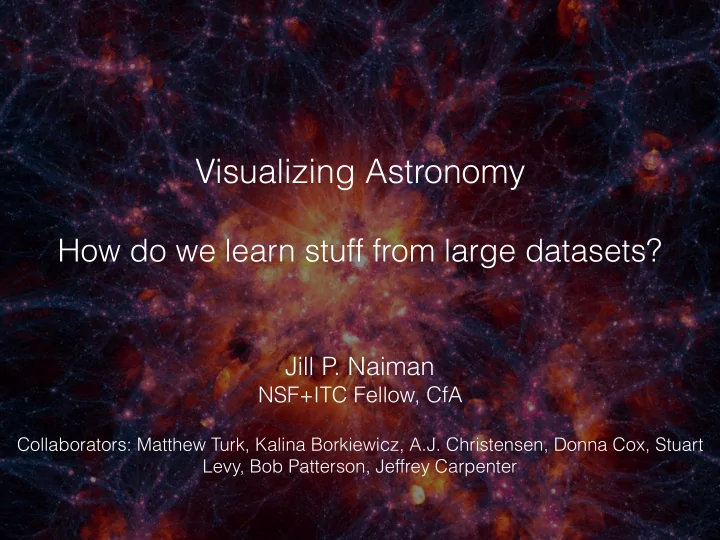

Visualizing Astronomy How do we learn stuff from large datasets? Jill P. Naiman NSF+ITC Fellow, CfA Collaborators: Matthew Turk, Kalina Borkiewicz, A.J. Christensen, Donna Cox, Stuart Levy, Bob Patterson, Jeffrey Carpenter
Big Data in My Own Work: The Illustris Simulations ✦ Super computer simulations of how galaxies form in our Universe ✦ Track motions of both gas and dark matter ✦ Includes other physics: how stars form, effects of magnetic fields, how elements are created and released into the Universe, etc ✦ Simulations get “big”: 100 billion particles/cells to follow each with its own physics - run on ~60,000 cores for several months - “snapshot” files are around 1-5 TB How the HECK do we know what is going on in our data?
Big Data in Observational Data too LSST: 200PB/decade expected New instruments Sloan Digital Sky Survey (SDSS): ~120TB = Dark Energy Survey (DES): ~200GB/night, more data ~PB in last decade. Square Kilometre Array (SKA): 1000 PB per year expected GIGANTIC camera with 3.2 gigapixels
Workflow of a Typical Computational Astrophysicist (AMR) (SPH) Pick a code for your physics problem. Add physics: (how stars form, supernovae feedback, how elements are created/destroyed, sources of material/heat external to your simulation domain…) Send to supercomputer… and wait Visualize and Analyze Usually special program for the specific AMR/SPH code, or yt
Workflow of a Typical Computational Astrophysicist (AMR) (SPH) Pick a code for your physics problem. Add physics: (how stars form, supernovae feedback, how elements are created/destroyed, sources of material/heat external to your simulation domain…) Send to supercomputer… and wait Visualize and Analyze Make a super cool movie
Workflow of a Typical Computational Astrophysicist (AMR) (SPH) Pick a code for your physics problem. Add physics: (how stars form, supernovae feedback, how elements are created/destroyed, sources of material/heat external to your simulation domain…) What is an effective and intuitive way to do this? Send to supercomputer… and wait Visualize and Analyze Make a super cool movie
Searching for Fast, Intuitive, Open Access Visualization in the Land of Big Datasets Isosurfaces Requirements to implementing this workflow - low latency - fast access to remote data - both stunning visuals AND analysis capabilities Ease of handing data over to large studios vs. giving early career scientists tools for their own visualization tools.
Combining Visualization and Analysis … where we are High-end 3D modeling, Viz and analysis packages volume rendering, Visual written for scientists Effects, etc IDL Maya yt Blender astropy Houdini VisIt ParaView Vapor Websites with 3D Glue Capabilities: Misc Python packages Sketchfab (I’m sure I’m missing your Thingverse favorite!) Google Sketchup
Combining Visualization and Analysis … a collection of fun things as a place to start…
AstroBlend www.astroblend.com Naiman 2016
AstroBlend www.astroblend.com Naiman 2016
AstroBlend www.astroblend.com Analysis plots are made to be interactive Naiman 2016
AstroBlend www.astroblend.com Soares-Furtado et al. in prep Naiman 2016
AstroBlend www.astroblend.com Naiman 2016
AstroBlend www.astroblend.com Code, Tutorials, Resources on the website and Bitbucket Repo Naiman 2016
Ytini www.ytini.com Naiman et al. 2017
Ytini www.ytini.com Naiman et al. 2017
Ytini www.ytini.com Naiman et al. 2017 http://ytini.com/blogs/blog_amr_2016-11-02.html
Sketchfab fun with Banneker/Aztlan Institutes www.astroblend.com/ba2016
Some final thoughts on increasing access to science Second week - make 2D and 3D movies of the planetary systems and galaxies First week - calculate orbits of planetary systems and motion of stars in merging galaxies www.astroblend.com/ba2016
Some final thoughts on increasing access to science
Some final thoughts on increasing access to science Moved on to: 3D Planets https://skfb.ly/RyZo 3D Galaxies https://skfb.ly/QHwx
Where we go from here Requirements to implementing this workflow - low latency data preprocessing and AMR capabilities some capabilities in yt to - fast access to remote data be fully utilized - both stunning visuals AND analysis capabilities fuller integration of yt into Blender/Houdini (and Glue) Isosurfaces
Thank you! jill.naiman@cfa.harvard.edu ✦ www.astroblend.com ✦ http://yt-project.org/ ✦ http://bannekerinstitute.fas.harvard.edu/about ✦ http://www.ncsa.illinois.edu/ ✦ www.sketchfab.com/jnaiman ✦ www.ytini.com ✦ www.astroblend.com/ba2016
Recommend
More recommend